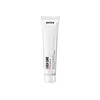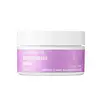What's inside
What's inside
 Key Ingredients
Key Ingredients

 Benefits
Benefits

 Concerns
Concerns

 Ingredients Side-by-side
Ingredients Side-by-side

Water
Skin ConditioningCaprylic/Capric Triglyceride
MaskingPropanediol
SolventGlycerin
HumectantSorbitan Stearate
EmulsifyingStearyl Alcohol
EmollientCetyl Alcohol
Emollient1,2-Hexanediol
Skin ConditioningTrehalose
HumectantVinyldimethicone
Glyceryl Stearate
EmollientCentella Asiatica Extract
CleansingHydrogenated Lecithin
EmulsifyingArginine
MaskingMadecassoside
AntioxidantCalamine
AbsorbentHydroxyethyl Acrylate/Sodium Acryloyldimethyl Taurate Copolymer
Emulsion StabilisingSorbityl Laurate
EmulsifyingPhytosteryl/Octyldodecyl Lauroyl Glutamate
Skin ConditioningSynthetic Beeswax
Emulsion StabilisingBehenyl Alcohol
EmollientCarbomer
Emulsion StabilisingCamellia Sinensis Leaf Extract
AntimicrobialPyrus Malus Leaf Extract
Skin ConditioningJasminum Officinale Flower Water
MaskingGlycol Stearate Se
EmulsifyingBetaine
HumectantCetearyl Alcohol
EmollientStearic Acid
CleansingGlyceryl Acrylate/Acrylic Acid Copolymer
HumectantPrunus Amygdalus Amara Kernel Oil
MaskingVanilla Planifolia Fruit Extract
Skin ConditioningXanthan Gum
EmulsifyingProtease
ExfoliatingDisodium EDTA
Water, Caprylic/Capric Triglyceride, Propanediol, Glycerin, Sorbitan Stearate, Stearyl Alcohol, Cetyl Alcohol, 1,2-Hexanediol, Trehalose, Vinyldimethicone, Glyceryl Stearate, Centella Asiatica Extract, Hydrogenated Lecithin, Arginine, Madecassoside, Calamine, Hydroxyethyl Acrylate/Sodium Acryloyldimethyl Taurate Copolymer, Sorbityl Laurate, Phytosteryl/Octyldodecyl Lauroyl Glutamate, Synthetic Beeswax, Behenyl Alcohol, Carbomer, Camellia Sinensis Leaf Extract, Pyrus Malus Leaf Extract, Jasminum Officinale Flower Water, Glycol Stearate Se, Betaine, Cetearyl Alcohol, Stearic Acid, Glyceryl Acrylate/Acrylic Acid Copolymer, Prunus Amygdalus Amara Kernel Oil, Vanilla Planifolia Fruit Extract, Xanthan Gum, Protease, Disodium EDTA
Water
Skin ConditioningDipropylene Glycol
HumectantGlycerin
HumectantMethyl Trimethicone
Skin ConditioningCetearyl Alcohol
EmollientUndecane
EmollientBehenyl Alcohol
EmollientTriolein
Skin Conditioning1,2-Hexanediol
Skin ConditioningButyrospermum Parkii Butter
Skin ConditioningTridecane
PerfumingCetearyl Olivate
Dipentaerythrityl Hexahydroxystearate/Hexastearate/Hexarosinate
Skin ConditioningSorbitan Olivate
EmulsifyingEclipta Prostrata Leaf Extract
Skin ConditioningLaminaria Japonica Extract
Skin ProtectingGlyceryl Dioleate
EmollientPalmitic Acid
EmollientStearic Acid
CleansingHydrogenated Lecithin
EmulsifyingCetearyl Glucoside
EmulsifyingButylene Glycol
HumectantAmmonium Acryloyldimethyltaurate/Vp Copolymer
Glyceryl Stearate Se
EmulsifyingCentella Asiatica Extract
CleansingFicus Carica Fruit Extract
HumectantCeramide NP
Skin ConditioningEclipta Prostrata Extract
Skin ConditioningC12-15 Alkyl Benzoate
AntimicrobialMelia Azadirachta Leaf Extract
Skin ConditioningCholesterol
EmollientXanthan Gum
EmulsifyingMelia Azadirachta Flower Extract
Skin ConditioningFructooligosaccharides
HumectantCoccinia Indica Fruit Extract
Skin ConditioningBeta-Glucan
Skin ConditioningDisodium EDTA
Amaranthus Caudatus Seed Extract
Skin ConditioningUlmus Davidiana Root Extract
Skin ConditioningAloe Barbadensis Flower Extract
EmollientSolanum Melongena Fruit Extract
Skin ConditioningHydrolyzed Hyaluronic Acid
HumectantMyristic Acid
CleansingMoringa Oleifera Seed Oil
EmollientOcimum Sanctum Leaf Extract
Skin ConditioningGlycine
BufferingTocopherol
AntioxidantCorallina Officinalis Extract
Skin ConditioningCurcuma Longa Root Extract
MaskingSerine
MaskingGlutamic Acid
HumectantGuaiazulene
AntimicrobialAspartic Acid
MaskingLeucine
Skin ConditioningAlanine
MaskingLysine
Skin ConditioningArginine
MaskingTyrosine
MaskingPhenylalanine
MaskingProline
Skin ConditioningThreonine
Valine
MaskingIsoleucine
Skin ConditioningHelianthus Annuus Seed Oil
EmollientHistidine
HumectantCysteine
AntioxidantMethionine
Skin ConditioningWater, Dipropylene Glycol, Glycerin, Methyl Trimethicone, Cetearyl Alcohol, Undecane, Behenyl Alcohol, Triolein, 1,2-Hexanediol, Butyrospermum Parkii Butter, Tridecane, Cetearyl Olivate, Dipentaerythrityl Hexahydroxystearate/Hexastearate/Hexarosinate, Sorbitan Olivate, Eclipta Prostrata Leaf Extract, Laminaria Japonica Extract, Glyceryl Dioleate, Palmitic Acid, Stearic Acid, Hydrogenated Lecithin, Cetearyl Glucoside, Butylene Glycol, Ammonium Acryloyldimethyltaurate/Vp Copolymer, Glyceryl Stearate Se, Centella Asiatica Extract, Ficus Carica Fruit Extract, Ceramide NP, Eclipta Prostrata Extract, C12-15 Alkyl Benzoate, Melia Azadirachta Leaf Extract, Cholesterol, Xanthan Gum, Melia Azadirachta Flower Extract, Fructooligosaccharides, Coccinia Indica Fruit Extract, Beta-Glucan, Disodium EDTA, Amaranthus Caudatus Seed Extract, Ulmus Davidiana Root Extract, Aloe Barbadensis Flower Extract, Solanum Melongena Fruit Extract, Hydrolyzed Hyaluronic Acid, Myristic Acid, Moringa Oleifera Seed Oil, Ocimum Sanctum Leaf Extract, Glycine, Tocopherol, Corallina Officinalis Extract, Curcuma Longa Root Extract, Serine, Glutamic Acid, Guaiazulene, Aspartic Acid, Leucine, Alanine, Lysine, Arginine, Tyrosine, Phenylalanine, Proline, Threonine, Valine, Isoleucine, Helianthus Annuus Seed Oil, Histidine, Cysteine, Methionine
Ingredients Explained
These ingredients are found in both products.
Ingredients higher up in an ingredient list are typically present in a larger amount.
1,2-Hexanediol is a synthetic liquid and another multi-functional powerhouse.
It is a:
- Humectant, drawing moisture into the skin
- Emollient, helping to soften skin
- Solvent, dispersing and stabilizing formulas
- Preservative booster, enhancing the antimicrobial activity of other preservatives
Arginine is an amino acid that is important for human development. Your body uses is it to produce hair keratin and skin collagen.
As a cosmetic ingredient, Arginine has antioxidant properties and can also help repair damaged skin. This ingredient is derived either synthetically or from animals.
Arginine isn't fungal acne safe when used in the presence of other lipids (fats, fatty acids, oils, esters, etc). Oils and fats occur naturally within the skin, so take caution when using Arginine if you're prone to fungal acne.
Learn more about ArginineBehenyl Alcohol is a type of fatty alcohol (these are different from the drying, solvent alcohols).
Fatty Alcohols have hydrating properties and are most often used as an emollient or to thicken a product. They are usually derived from natural fats and oils; behenyl alcohol is derived from the fats of vegetable oils.
Emollients help keep your skin soft and hydrated by creating a film that traps moisture in.
In 2000, Behenyl Alcohol was approved by the US as medicine to reduce the duration of cold sores.
Learn more about Behenyl AlcoholCentella Asiatica Extract (Centella) is derived from an herb native to Southeast Asia. It is famous for its anti-inflammatory and soothing properties.
Centella is rich in antioxidants and amino acids, such as Madecassic Acid and Asiaticoside.
Studies show the compounds in centella help with:
The combination of all these properties makes centella effective at soothing, hydrating, and protecting the skin.
Other great components of centella include Vitamin A, vitamin C, several B vitamins, and Asiatic Acid.
Fun fact: Centella has been used as a medicine and in food for many centuries. As a medicine, it is used to treat burns, scratches, and wounds.
Learn more about Centella Asiatica ExtractCetearyl alcohol is a mixture of two fatty alcohols: cetyl alcohol and stearyl alcohol. It is mainly used as an emulsifier. Emulsifiers help prevent the separation of oils and products. Due to its composition, it can also be used to thicken a product or help create foam.
Cetearyl alcohol is an emollient. Emollients help soothe and hydrate the skin by trapping moisture.
Studies show Cetearyl alcohol is non-toxic and non-irritating. The FDA allows products labeled "alcohol-free" to have fatty alcohols.
This ingredient is usually derived from plant oils such as palm, vegetable, or coconut oils. There is debate on whether this ingredient will cause acne.
Due to the fatty acid base, this ingredient may not be Malassezia folliculitis safe.
Learn more about Cetearyl AlcoholDisodium EDTA plays a role in making products more stable by aiding other preservatives.
It is a chelating agent, meaning it neutralizes metal ions that may be found in a product.
Disodium EDTA is a salt of edetic acid and is found to be safe in cosmetic ingredients.
Learn more about Disodium EDTAGlycerin is already naturally found in your skin. It helps moisturize and protect your skin.
A study from 2016 found glycerin to be more effective as a humectant than AHAs and hyaluronic acid.
As a humectant, it helps the skin stay hydrated by pulling moisture to your skin. The low molecular weight of glycerin allows it to pull moisture into the deeper layers of your skin.
Hydrated skin improves your skin barrier; Your skin barrier helps protect against irritants and bacteria.
Glycerin has also been found to have antimicrobial and antiviral properties. Due to these properties, glycerin is often used in wound and burn treatments.
In cosmetics, glycerin is usually derived from plants such as soybean or palm. However, it can also be sourced from animals, such as tallow or animal fat.
This ingredient is organic, colorless, odorless, and non-toxic.
Glycerin is the name for this ingredient in American English. British English uses Glycerol/Glycerine.
Learn more about GlycerinHydrogenated Lecithin is created from the hydrogenation of lecithin (a group of phospholipids). Hydrogenation is a chemical reaction between hydrogen and another element.
This ingredient is an emollient and emulsifier. As an emollient, it helps soften skin by trapping moisture within. As an emulsifier, it prevents oil and water ingredients from separating.
Stearic Acid is a fatty acid. It is an emollient, emulsifier, and texture enhancer.
As an emollient, stearic acid helps soften skin. It aids the skin's protective barrier by preventing water loss. It also provides a gentle cleansing effect without stripping away natural oils.
Stearic acid may also be used to enhance the texture of products. It can add volume and stabilize ingredients such as water and oil. This can help water and oil ingredients from separating.
Sources of stearic acid include animal or vegetable fats/oils such as coconut or shea. It can be naturally found in butter, cocoa butter, shea butter, vegetable fats, and animal tallow.
This ingredient may not be Malassezia folliculitis, or fungal-acne safe.
Learn more about Stearic AcidWater. It's the most common cosmetic ingredient of all. You'll usually see it at the top of ingredient lists, meaning that it makes up the largest part of the product.
So why is it so popular? Water most often acts as a solvent - this means that it helps dissolve other ingredients into the formulation.
You'll also recognize water as that liquid we all need to stay alive. If you see this, drink a glass of water. Stay hydrated!
Learn more about WaterXanthan gum is used as a stabilizer and thickener within cosmetic products. It helps give products a sticky, thick feeling - preventing them from being too runny.
On the technical side of things, xanthan gum is a polysaccharide - a combination consisting of multiple sugar molecules bonded together.
Xanthan gum is a pretty common and great ingredient. It is a natural, non-toxic, non-irritating ingredient that is also commonly used in food products.
Learn more about Xanthan Gum